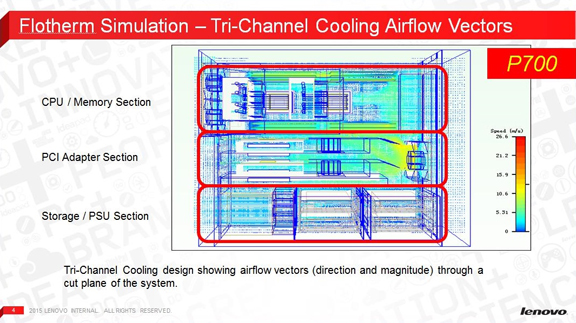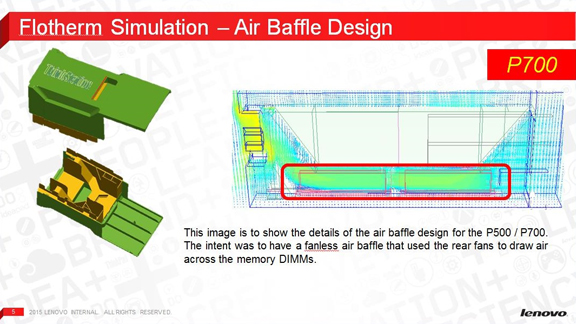
Lenovo ThinkStation P Series uses a tri-channel cooling system to direct airflow and heat. The image here shows simulated airflow inside FloTHERM.
Latest News
March 24, 2015
 Lenovo ThinkStation P Series uses a tri-channel cooling system to direct airflow and heat. The image here shows simulated airflow inside FloTHERM.
Lenovo ThinkStation P Series uses a tri-channel cooling system to direct airflow and heat. The image here shows simulated airflow inside FloTHERM. The air baffle in ThinkStation P series allows engineers to reduce the reliance on fans to keep the system cool.
The air baffle in ThinkStation P series allows engineers to reduce the reliance on fans to keep the system cool.Some heavy computer users assume—in what seem to them like sound logic—that if their workstation is showing signs of extreme heat load (loud fan noise would be one of the symptoms), they can cool off the machine by opening up the side or back panel. That, Al Makley from Lenovo pointed out, can do more harm than good.
As director of Architecture and Technical Solutions at Lenovo’s ThinkStation product line, Makley spent a lot of times thinking about what goes on under the hood of a computer. “The cover is an instrumental part of the machine’s thermal regulation,” he explained. “By removing the cover, you are removing the negative pressure inside the chassis. Without that negative pressure, you have no airflow on your hard drives, so they’re now subject to overheat.”
In older generation computers, the placement of components—CPUs, GPUs, motherboard, heat sinks, fans, and hard drives—was much more forgiving, but the demand to pack a lot more into a smaller form factor in modern workstations leaves little space to waste inside the chassis. That calls for more sophisticated approaches to directing the airflow within the box.
In a standard computer housed inside a tower box, Makley saw what he called “mixed airflow”—“for instance, heat from the graphics adaptor influencing the memory DIMs and the CPUs,” he noted. In the Lenovo ThinkStation P series, the company’s patented tri-channel cooling system functions as a heat regulator. The design represents a more refined derivative of the system first introduced in ThinkStation C20, which debut in 2011.
“It segments the chassis into three separate compartments,” explained Makley. “One compartment works to cool the hard drives and power supplies, another to cool the memory and the CPUs, and the third to cool the PCI channel in the graphics adaptor. Within those compartments, we make sure there’s clear front-to-back airflow to bring cool air in and pump warm air out, with no cross-compartment heat propagation.”
With mechanical components, you can see their interactions with your naked eyes. Not so with the behavior of heat and airflow inside a computer’s closed chassis, Makley pointed out. “Thermal design is very difficult to comprehend. That’s where you need simulation,” he said. “It tells you with clear vector arrows where the air is flowing.”
For thermal simulation, Lenovo uses FloTHERM, acquired by Mentor Graphics in 2008. With software-driven simulation, Makley believes he and his team can get to about 90-95% accuracy in predicting the airflow. The rest—the 5-10% margin—may be attributed to the approximation engineers must use. “For instance, with a real fan, the impeller shape would determine the airflow direction—it could be blowing at 40, 45, or 50 degree angle” he explained. “In simulation software, you may have to guess that angle and use it as an input.” Lenovo uses physical tests—usually conducted with cardboard structures mimicking the chassis design—to verify the software’s predictions.
“Of all the P series workstations, the P 900 proves a lot more challenging to design because of the additional PCI-e slots that it must accommodate,” Makley explained. “So we added a highly efficient rare system fan to draw the airflow from the upstream pressure sources. It has an effective air baffle to deliver fresh air to both the upstream and downstream CPUs. The same airflow also cools the memory DIMs adjacent to the CPUs—all accomplished with one self-contained air baffle.”
Fans are the best solution to counteract the heat sources, but they’re also additional risks for failure. As moving mechanical components, fans are prone to breaking; they also produce considerable noise when activated. So Makley and his colleagues wanted to design the P900 with as few fans as possible. “We managed to cool the entire system with only three fans,” Makley pointed out. “Our competition uses a lot more moving parts in their comparable product segments to do this.
Subscribe to our FREE magazine, FREE email newsletters or both!
Latest News
About the Author
Kenneth Wong is Digital Engineering’s resident blogger and senior editor. Email him at [email protected] or share your thoughts on this article at digitaleng.news/facebook.
Follow DE





